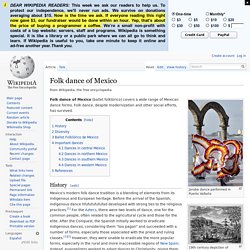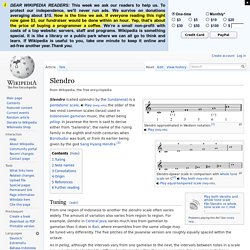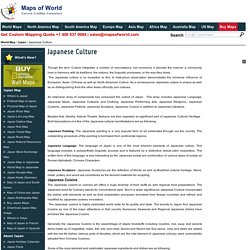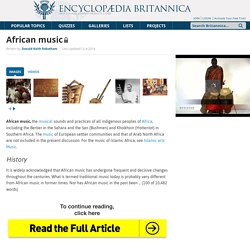

Folk dance of Mexico. Jarabe dance performed in Puerto Vallarta Folk dance of Mexico (ballet folklórico) covers a wide range of Mexican dance forms.

Folk dance, despite modernization and other social efforts, has survived. History[edit] 19th century depiction of indigenous dance Mexico’s modern folk dance tradition is a blending of elements from its indigenous and European heritage. Dance as depicted in "Mexico, California and Arizona; being a new and revised edition of Old Mexico and her lost provinces" (1900).
Today, traditional Mexican folk dance is a defining element of Mexico’s popular culture nationally and internationally. Mexican folk dance has had an important impact on the culture of the United States, especially in Mexican American communities. Diversity[edit] Mexican folk dance is an uneven synthesis of different cultural traditions. Conchero dance blowing conch shell in Amecameca. Ballet Folklórico de México[edit] Mexico Music Traditional Beat! (Mini-Mix) Mexican performer. Klezmer performer. Klezmer-music. Budapest Klezmer Band. Slendro. Slendro approximated in Western notation.[1] Play Play the older of the two most common scales (laras) used in Indonesian gamelan music, the other being pélog.

In Javanese the term is said to derive either from "Sailendra", the name of the ruling family in the eighth and ninth centuries when Borobudur was built, or from its earlier being given by the god Sang Hyang Hendra.[3] Tuning[edit] From one region of Indonesia to another the slendro scale often varies widely. Note names[edit] In Java, the notes of the slendro scale can be designated in different ways; one common way is the use of numbers often called by their names in Javanese, especially in a shortened form.
The name barang is also sometimes used for 1 in slendro (it is the usual name for 7 in pelog); the octave is then designated as barang alit. In Bali, the scale starts on the note named ding, and then continue going up the scale to dong, deng, dung and dang. Connotations[edit] Indonesian performer. Great Indonesian Music: Shanty - Oh, Kasih. Japanese performer. Traditional Japanese Modern Music. Japanese Culture, Culture of Japan. Though the term Culture integrates a number of connotations, but commonly it denotes the manner a community lives in harmony with its traditions, the notions, the linguistic processes, or the way they dress.

The Japanese culture is no exception to this. A meticulous observation demonstrates the immense influence of European, Asian, Chinese as well as North American Culture. As a consequence Japanese culture is unique as well as so distinguishing from the other Asian ethnicity and cultures. An extensive array of components has composed the culture of Japan . This array includes Japanese Language, Japanese Music, Japanese Costume and Clothing, Japanese Performing Arts, Japanese Religions, Japanese Customs, Japanese Folklore, Japanese Sculpture, Japanese Cuisine in addition to Japanese Literature.
Besides that, Geisha, Kabuki Theatre, Ikebana are also regarded as significant part of Japanese Cultural Heritage . Celtic performer. Folk music of Ireland. Traditional music sessions are commonplace in public houses throughout Ireland The folk music of Ireland (also known as Irish traditional music, Irish trad, Irish folk music, and other variants) is the generic term for music that has been created in various genres in Ireland.

Irish traditional music has survived more strongly against the forces of cinema, radio and the mass media than the indigenous folk music of most European countries. This was possibly due to the fact that the country was not a geographical battleground in either of the two world wars. [citation needed] Another potential factor was that the economy was largely agricultural, where oral tradition usually thrives[citation needed]. Celtic Music 10 hours. Performer from Africa. Putumayo Compilation - African Music. Encyclopedia Britannica. African music, the musical sounds and practices of all indigenous peoples of Africa, including the Berber in the Sahara and the San (Bushmen) and Khoikhoin (Hottentot) in Southern Africa.

The music of European settler communities and that of Arab North Africa are not included in the present discussion. For the music of Islamic Africa, see Islamic arts: Music. It is widely acknowledged that African music has undergone frequent and decisive changes throughout the centuries. What is termed traditional music today is probably very different from African music in former times. Nor has African music in the past been ... (100 of 10,482 words) <ul><li><a href="/EBchecked/media/126432/Man-playing-traditional-mangolongondo-instrument-Malawi?